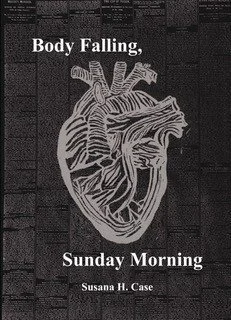Body Falling, Sunday Morning by Susana H. Case, Reviewed by Editor Kristiane Weeks-Rogers
A pulse echoes throughout Susana H. Case’s chapbook collection, Body Falling, Sunday Morning. From the first poem, “No Signs of Activity”—where “Blood blooms more robust / than the flowers stenciled / on the yellow, blue, and white / kitchen linoleum”— Case’s writing erupts with color and movement, juxtaposing the lifelessness of the crime it references. This use of color and movement carries from her first poem to the last, thus paying homage to the life of Glessner Lee and Lee’s beautiful, morbid crime scene diagrams.
Can crime scenes be art? Case argues, yes, and I agree. Mixed with complex homicide topics, Case’s combination of text/image relationships creates artistic meaning through crime scenes. The mundane settings become a mystery to unravel, which is stated in the poem, “Jane Doe”: “Because something’s always hidden, / aggression hidden in the linen.” Case allows the reader to navigate these horrendous scenes through simple diction and short lines; in considering the crime scenes, we utilize Case’s language and Lee’s diagrams to decipher the unknown.
Interspersed throughout the recreation of these gruesome crimes, there are moments of reprieve, giving readers time to breathe. The ekphrastic poems are braided with bits about Glessner Lee. Case is quick to display not only the detailed dollhouse playset-like puzzles, but the psychology behind Lee’s motives as well: “Obsessed, she writes: This has been a lonely and rather terrifying life I have lived.” Case draws a parallel between Lee and Lee’s diagrams, suggesting that Lee studies lonely and terrifying moments of others’ lives to understand her (our) own.
While the tone of Bodies Falling, Sunday Morning is dark, there are moments where reading mimics meditation. Personally, I find these moments happen, perhaps oddly, where the images are placed. The diagram-pictures invite time to deeply study the tiny and precise details created by Lee’s hand. As Case notes, “Everything works—window shades, mousetraps, hinges on doors. Puzzles impossible to solve.” We are left to imagine the pause and reflection through Lee and beyond her, as well. In this way, Bodies Falling, Sunday Morning creates a gap in time where death and crime can be used to consider the nuances of life more profoundly.
May 2020
Kristiane Weeks-Rogers
Kristiane Weeks-Rogers grew up around Lake Michigan and earned higher education degrees in Florida and Indiana in English and Creative Writing. She earned her MFA at Naropa University’s Jack Kerouac School of Disembodied Poetics in Boulder, Colorado. She currently teaches writing and composition courses at the collegiate level. She enjoys hiking, creating arts, and drinking coffee and libations with her husband around the Rocky Mountains while discovering what ghosts really are.



